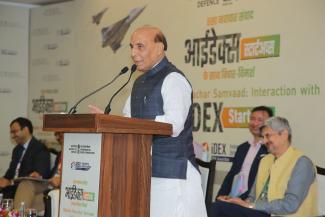Algorithmic Warfare: India’s Leap Into AI-Driven Defence Modernity
Recently, during the conference titled “Raksha Navachar Samvaad: Interaction with iDEX Startups,” held ahead of the National Conference on Defence Innovation at Vigyan Bhawan in New Delhi on October 7, Defence Minister Rajnath Singh stated that the nature of warfare is rapidly evolving. He noted that future conflicts will be shaped by artificial intelligence (AI), autonomous systems, drones, quantum computing, and directed-energy weapons. Singh urged innovators and startups to pioneer cutting-edge defence technologies and make India a global leader in innovation. He emphasized that “the battlefield has changed. The wars of tomorrow will be fought with algorithms, autonomous systems, and artificial intelligence.”[i] According to him, drones, anti-drone systems, quantum computing, and directed-energy weapons will define the future of warfare.
The Defence Minister clearly implied that India had already employed some of these technologies with considerable success during Operation Sindoor. He called upon Indian innovators to “think beyond existing solutions” and create technologies capable of redefining modern warfare. The focus of his remarks was that scientists, the military, and industry must shed the mindset of being mere imitators or followers. Instead, India must strive to become a creator and standard-setter in defence innovation, with substantial investment in research and development.
Essentially, his speech brought to the forefront the concept of algorithmic warfare, a term that has gained significant traction in both technological and military circles in recent years.[ii] Broadly speaking, algorithmic warfare refers to the use of algorithms in the development of military systems and tactics, primarily through AI and machine learning (ML). These technologies enhance a wide range of military operations by processing vast amounts of data from various sources, including satellite imagery, drones, sensors, and cyber networks. This data integration provides commanders with a clearer, real-time picture of the battlefield, enabling faster and more accurate decision-making. By embedding AI into command-and-control systems, militaries seek to gain a strategic advantage through speed, automation, and enhanced situational awareness.
Although algorithmic warfare is often viewed as a relatively new concept, its origins can be traced back to the World War II era, when early advances in computing technology began to influence military systems. By the 1960s, automated air defence systems had entered service, marking the early stages of algorithmic application in defence. As computing power increased over subsequent decades, militaries began using machines to process and analyse large data sets in short time frames. The evolution from basic computers to supercomputers, and now to quantum computing, has been instrumental in transforming military operations. Miniaturization of components through nanotechnology, the explosion of big data, and cloud computing have all contributed to making military systems more intelligent, faster, and more precise.
By the late 20th century, militaries were employing algorithms for training, logistics, and administrative functions. The 21st century, however, has witnessed an unprecedented revolution in AI and ML technologies, giving a major boost to the concept of algorithmic warfare. Recent conflicts have demonstrated that AI-driven technologies can transform battlefield decision-making by fusing and analysing data from multiple sources. Such systems not only provide commanders with a sharper operational picture but also generate actionable recommendations in real time.
Today, military weapon systems span a spectrum—from remotely piloted vehicles and automated defensive interceptors to highly integrated networks that connect sensors, decision aids, and weapon platforms. Algorithmic warfare reinforces the concept of network-centric warfare (NCW), which combines sensors, shooters, and decision-makers through robust information networks to facilitate rapid decision-making cycles.
At the operational level, algorithmic warfare enables autonomous and semi-autonomous systems—such as drones, loitering munitions, and cyber tools—to function with minimal or no human intervention. Militaries are increasingly deploying AI in intelligence, surveillance, and reconnaissance (ISR) to detect patterns, identify threats, and predict enemy actions. While algorithmic systems promise efficiency and strategic superiority, they also pose serious challenges, including algorithmic bias, vulnerability to adversarial manipulation, and the potential for unintended escalation in conflict situations. A key debate surrounding algorithmic warfare centers on the role of humans in the decision-making process. Should a human remain “in-the-loop,” directly authorizing lethal actions, or should machines operate “outside-the-loop,” making autonomous decisions in real time?[iii] Many argue that human oversight is essential for ensuring judgment, context, and accountability, qualities that machines inherently lack. Others contend that fully autonomous systems are inevitable, as modern warfare demands speed, endurance, and the ability to operate in communication-denied environments where human input is impractical. Advocates of autonomy also suggest that algorithmic decisions may be more objective, with lower margins of human error.
It is worth noting that significant ethical debates are currently underway globally regarding the use of algorithmic systems in military technology. Several voices have called for an international consensus or regulatory mechanism to govern the development and deployment of AI-driven military systems. Yet, the major powers have adopted mainly a “wait-and-see” approach, reluctant to commit to binding frameworks while technologies are still evolving and the strategic implications remain uncertain.
In essence, algorithmic warfare is here to stay. It is transforming the very nature of modern conflict by enhancing speed, precision, and decision-making capabilities through the use of AI and automation. The operational and strategic advantages it offers are immense and undeniable. India, therefore, must continue to invest robustly in this domain, building indigenous capabilities, fostering research, and ensuring that innovation in defence technology keeps pace with the rapidly changing character of war.
Notes
[i] Raksha Mantri Shri Rajnath Singh speaking at Navachar Samvaad: Interaction with iDEX Startups, Defence Production India (X@DefProdnIndia), October 07, 2025, https://x.com/i/broadcasts/1yoKMPYgeARxQ
[ii] Ingvild Bode (et.al.), "Algorithmic Warfare: Taking Stock of a Research Programme", Global Society, Vol. 38, pp.1-23, 2024. 10.1080/13600826.2023.2263473.
[iii] Michael Pilling, "Issues Regarding the Future Application of Autonomous Systems to Command and Control (C2)", Joint and Operations Analysis Division, Defence Science and Technology Organisation, Australia. https://apps.dtic.mil/sti/pdfs/ADA620307.pdf
